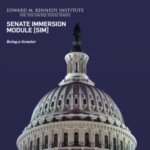The United States Congress consists of two legislative bodies, the House of Representatives and the Senate. There are many similarities between these institutions. Representatives and Senators are directly elected by the public (see Capitol Visitor Center essay “Who Elects Our Senators?”). Passing legislation requires the agreement of both the House and Senate. There are chambers for both in the U.S. Capitol. Given these commonalities, are there really differences between the House and Senate?
How House and Senate Committees Work
Committees improve the organization of the Senate and House of Representatives. Members of Congress can’t be experts on all issues. For this reason, the Senate and House of Representatives developed committees that focus on particular subjects. Committees look at the way that government functions; identify issues that require review; gather and evaluate information; and make legislative
recommendations to the full House or Senate.
Who Elects Our Senators
United States senators have been elected directly by voters since 1913. Prior to that time, state legislatures chose the state’s senators. In the mid-1850s, however, the state legislature selection process began to fail due to political infighting and corruption. Often Senate seats were left vacant for long periods of time while state legislatures debated who to send to the Senate.
House vs. Senate for Grades 6-12
A three part media-based lesson about exploring the differences between the House and the Senate. Students will present their findings in a 1-3 minute video.
Senate Immersion Module Curriculum

The materials in this curriculum are designed to enhance the Institute’s immersive SIM experience. The SIM is an educational, game-like experience, developed to engage new generations of Americans. This program is conducted in the Institute’s full- scale representation of the United States Senate Chamber. Running with up to 100 students at a time, participants take on the roles of senators to learn about representation, study issues, debate, negotiate, and vote on legislation.
Lesson Plan: Choice Board – Researching Your U.S. Senators
This lesson provides students with the opportunity to explore their members of the U.S. Senate and how they represent their constituents as a fundamental part of civic literacy.
Congress by the Numbers
Together, the U.S. House of Representatives and U.S Senate are called Congress, the legislative branch of the federal government. Congress has many powers including writing the nation’s laws, approving treaties, and declaring war.
How Your State Gets Its Seats – Congressional Apportionment
The United States Senate consists of how many members? The answer is fairly simple: with two members apiece representing each of the fifty states, the total is one hundred. How about the House of Representatives? The answer is much more complicated. There are currently 435 voting members of the House of Representatives. How did this number come about and how is the number of Representatives per state determined?
Compromise at the Constitutional Convention
This activity is designed to help students understand the debates at the Constitutional Convention in 1787 that shaped America’s legislative branch of government. The primary goal is for students to discover how a compromise balanced the needs of large states and small states and how this led to the
creation of the current House of Representatives and Senate. In contrast to the real convention, this activity is simplified and focused to come to a conclusion in a class period.
Civic Conversations
How do educators invest in productive, deep, and transformative dialogue in their classrooms? Civic Conversations is a collaboration between the Edward M. Kennedy Institute’s civic education programming and the community-building dialogic structure practiced by Essential Partners. Explore resources, activities, and lesson structures that support educators as they facilitate difficult conversations, create inclusive learning environments, raise complex discussions, and promote a safe space for students to consider their values and engage in their communities. Policy simulations at the Kennedy Institute reflect the wide range of issues that face our country today. Students debate the best way to reform our immigration system, consider the balance between privacy and security, and think about how to meet the challenge of climate change. As in the real Senate, it’s natural that students will disagree on the best approach to many civic issues. This collection of resources will support educators as they prepare to discuss civic issues, either in preparation for a Kennedy Institute field trip or to practice listening, sharing, and learning in the classroom.